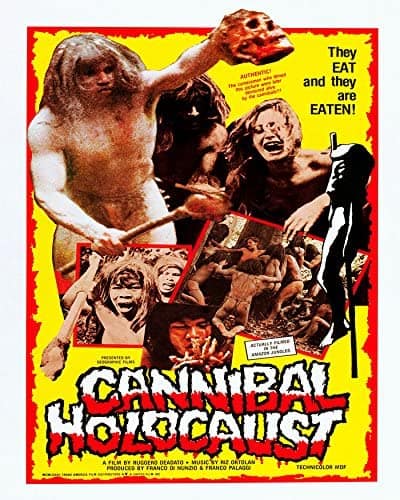MPAA Rating: UR/Genre: Found Footage Horror/ Stars: Robert Kerman, Gabriel Yorke, Luca Giorgio Barbareschi, Francesca Ciardi, Perry Pirkanen, Salvatore Basile, Ricardo Fuentes, Paolo Paoloni, Lionello Pio Di Savoia, Luigina Rocchi, Enrico Papa, David Sage, Ruggero Deodato/ Runtime: 96 minutes
I think it must be said that as a film reviewer I must walk a very thin and very narrow line when choosing to write a review about the slice of cinematic pie that is Cannibal Holocaust. Indeed this infamous slice of horror cinema from 1980 and helmed by Ruggero Deodato has managed to collect for itself quite the intriguing reputation in the years since it first came out as well as finding itself being treated to suppression, legal dilemmas, (including the director having to actually go on trial because the court system in Italy genuinely thought he had murdered people), and scorn from a lot of the movie going community all while it manages to slowly but surely acquire a fan base all its own over the past 40-plus years that have made the choice to not only refuse to burn this movie at the proverbial stake like so many others have, but to view this slice of cinematic pie as trying to say something about the dual nature of the human condition. Yet even those who speak highly of this slice of cinematic pie will tell you that it most assuredly is by no means the kind of movie you will (usually) want to sit back and watch with your significant other on date night following a romantic dinner of filet mignon and a nice bottle of good ol’ fashioned vino. Suffice it to say that this is a very specific film for a very specific audience even though there really is, buried under all the violent and brutal things that go on in this movie, intriguing things and thematic concepts to unearth. Thus although this slice of cinematic pie is by no means an easy movie to make your way through, it is also (should you dare to brave it) an intriguing look back at a time in cinematic history that has come and gone. No you are not meant to walk away from this slice of cinematic pie completely unscathed, but it most assuredly provide up a distinct edge that is wonderfully unconventional in the best ways possible.
The plot is as follows: Deciding to embark to no less a location than the rainforests of the Amazon in order to uncover just what occurred to a group of filmmakers who went out there in order to film the tribes in the area, a professor by the name of Harold Monroe decides to team up with a rather infamous yet regarded to some degree tracker by the name of Cacho on an expedition that sees the two men going through some quite perilous area in the jungle known as “The Green Inferno” (so THAT’s where Eli Roth got the name for his cannibals in the Amazon film from) and eventually crossing paths with a pair of tribes in conflict with one another known as the Yanomamo and the Shamatari respectively. To that end, we see that our intrepid professor is able to win the natives over and as a result they are then able to help our academia-rooted friend find footage that was shot by the expedition he is looking for that was left with the natives along with a group of brutally mutilated human remains that may or may not be the documentary film crew themselves. From there, we see that, upon his return to New York City in order to get his own documentary done regarding the missing crew and their contributions to the world of being at the front lines of reporting, our hero decides to sit down and watch the footage he found only to be terrified by what he sees. Namely because the footage in question shows no more and no less how the crew genuinely acted while in the Amazon in regards to their behavior toward the natives in a perilous and quite potentially fatal attempt to conjure up sellable violence that they could then utilize to try and increase their images as members of the journalistic community….
Now it should be noted that this slice of cinematic pie actually gives you two films in one. That’s because this movie’s opening half revolves almost entirely around Professor Monroe’s odyssey into the Amazon with the aid of his guide Cacho and attempts to make his way to the heart of the jungle in order to see if he can find the natives that the other crew was searching for let alone some trace of the other crew period. Along the way, he will discover stifling heat and humidity, leaches in the river, and witness the stomach curdling ritual-based homicide of a woman caught cheating which ensures that we, along with the professor, are treated to a gut punching glimpse at what the people of this area are really all about as it were. At the same time though, this opening half is also the same locale where the film helmer is really able to set this movie’s tone into motion courtesy of a blend of terror and exploitation that is utilized in a way that is yes spine-tingling, but also anxiety-stricken. Not only to learn what really happened, but in regards to all the little stuff that happens along the way as well. From there, the back of the movie deals in Monroe watching the footage he found of the lost expedition which reveals things about the missing film crew that I think it best to leave you to discover for yourself. Suffice it to say that not only is it really about as low in terms of journalistic integrity as you could possibly get and then some, but it also has quite a lot to say about how even today we as a society really do have this perverse intrigue when it comes to trash TV a’la Jerry Springer and viral videos that had no business being filmed in the first place. Yes rather than assertively making his point on the nature of genuine savagery, the film’s helmer doesn’t quite sell the point as well as he could, but legit points are able to be raised on the nature of both media tinkering and criticism of other cultures in a way that is not educated in the least complete with a fairly intriguing philosophical question at the end of the film. Yes it can be quite difficult to see the value of a movie like this from the perspective of academia, but the fact that there is things to actually think about once the movie is over and, at least in the eyes of this reviewer, the fact that the film even made an effort to do so is something that is to be respected and admired.
With all of that said, I know that the most infuriating and infamous component to this movie is the fact that at various points throughout the film we are treated to the legit slaughter of several jungle critters including a large turtle, a snake, and a spider monkey among others. Indeed it is an element to this film that I feel is not only downright unpleasant, but also didn’t need to be part of the movie in the first place. I mean there is enough potent work being done here in regards to special effects to show that you could have easily done some special effects wizardry here to sell an audience without going to such extremes. Instead, though the fact that the film chooses to focus uncomfortably on these animals as they are in clear agony as well as their various internal organs simply transforms a quite potent movie into one that is just outright detestable in those moments. Sure certain people characters don’t exactly make it out of this scot-free either, but at least the people playing those characters were able to leave when the director yelled “cut!” Suffice it to say you don’t have to be a lifetime member of PETA to understand just why so many people have cried foul in regards to this film. It’s also worth noting that there is not a whole lot in the way of comedy or lightheartedness to be found here with the only exception being perhaps one scene where our professor decides to take a bath in the river only to find himself surrounded by native women. Other than that though, this movie’s vibe is brutal, but intriguingly quite welcoming thanks to a phenomenal musical accompaniment from Riz Ortolani who is able to find a melancholic and haunting orchestral style to help this film feel a lot more cinematic. Yes this movie also gives us electro jolts for when we’re supposed to be scared, but by and large the music in this is quite beautiful to say nothing of aiding the director in hiding some of the more gruesome ingredients this film’s director is working with. I also feel that the work done in the cinematography department is quite artistic as well due to how it manages to really conjure up a quite realistic “found footage” style for this movie’s second half that works phenomenally well despite the fact that the acting does tend to go a bit over the top.
All in all I know what you are thinking dear reader: how on Earth could a slice of cinematic pie like this one which is full to the brim with horrific amounts of sexual assault, mutilations of various bodily appendages on both people and animals and visceral homicide even come close to being something that I could possibly have half a heart to say that I recommend you sit down and watch? Well I’ll tell you: yes all the above ingredients I mentioned are part and parcel of this slice at cinematic pie so you have been warned. At the same time, this slice of cinematic pie may send a shiver down your spine and your stomach do some serious flips due to how gruesome it gets, but it is also is not entirely void of value with particular regard to those among you who will be able to comprehend and even to some perverse degree appreciate the degree of realistic that the film’s helmer is definitely aiming for with this movie. Yes he may choose to operate quite a bit with tropes that you have seen in horror cinema a million times before and yes the animals in this most assuredly did not need to be killed for real, but Deodato also does manage to conjure up quite the bitter vibe of discovery to it. One that demands that the viewer who chooses to sit down and watch this be talented at distinguishing between artificial goading and genuine cinematic technique. Suffice it to say that, if I hadn’t already said as much, Cannibal Holocaust is most certainly not a slice of cinematic pie for everyone and should only be viewed by those who are prepared to be taken by the hand to tour a truly ominous and wicked location and view a distinctly unrestrained period in cinematic history from a relatively sheltered interval. On a scale of 1-5 I give Cannibal Holocaust “80” a solid 3.5 out of 5.


